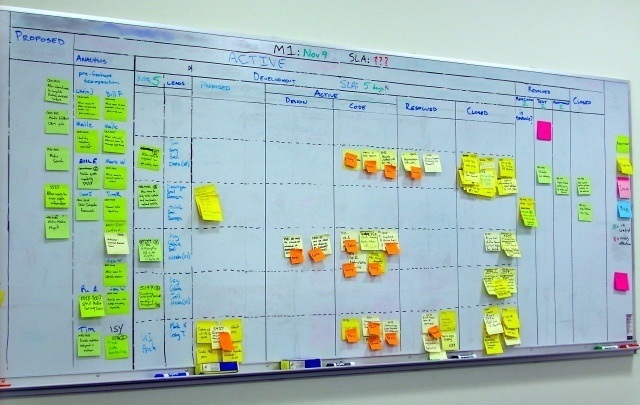Invisibility is an accidental and troublesome characteristic of knowledge work in a digital world. What makes it invisible? Why does it matter? What can you do about it?
How did knowledge work become invisible?
As a knowledge worker, I get paid for what happens inside my head but not until I get the work outside where it can be seen. Before the advent of a more or less ubiquitous digital environment, that head work generated multiple markers and visible manifestations. There were handwritten notes from interviews, a presentation might start with rough mockups of slides scribbled on a pad of paper. Flip charts would document the outcomes of a group brainstorming session. A consulting report would start as an outline on a legal pad that would be rearranged by literally cutting and pasting the paper into a new order and organization. Computer code started as forms to be filled out and forwarded to a separate department to transcribe the forms onto punch cards.
No one would want to return to that world of knowledge work.
Digital tools—text editors, word processors, spreadsheets, presentation software, email—have eliminated multiple manual, error-prone, steps. They’ve made many low-value roles obsolete—sometimes by unintentionally giving them back to high-cost knowledge workers.
These same tools also reduce the physical variety of knowledge work to a deceptively uniform collection of keystrokes stored as bits in digital files hiding behind obscure file names and equally uninformative icons. A laptop screen offers few clues about the knowledge work process compared to an office full of papers and books. A file directory listing appears pretty thin in terms of useful knowledge content compared to rows of books on shelves.
Why does the visibility of knowledge work matter?
If you can’t see it, you can’t manage or improve it. This is true as an individual knowledge worker and as a team or organization.
Noticing that digital work is invisible reminds us of benefits of analog work that weren’t obvious. Among those non-obvious benefits;
- Different physical representations (handwritten notes, typed drafts, 35mm slides) establish how baked a particular idea is
- Multiple stacks of work in progress make it easier to gauge progress and see connections between disparate elements of work
- Physically shared work spaces support incidental social interactions that enrich deliverables and contribute to the learning and development of multiple individuals connected to the effort
Consider how developing a presentation has changed over time. Before the advent of PowerPoint, presentations began with a pad of paper and a pencil. The team might rough out a set of potential slides huddled around a table in a conference room. Simply by looking at the roughed-out set of slides you knew that it was a draft; erasures, cross outs, and arrows made that more obvious.
A junior level staffer was then dispatched with the draft to the graphics department, where they were chastised for how little lead time they were provided. A commercial artist tackled the incomprehensible draft spending several days hand-lettering text and building the graphs and charts.
The completed draft was returned from the graphics department starting an iterative process, correcting and amending the presentation. The team might discover a hidden and more compelling story line by rearranging slides on a table or conference room wall or floor. Copies were circulated and marked up by the team and various higher ups. Eventually, the client got to see it and you hoped you’d gotten things right.
The work was visible throughout this old-style process. That visibility was a simple side effect of the work’s physicality. Contributors could assess their inputs in context. Junior staff could observe the process and witness the product’s evolution. Knowledge sharing was simultaneously a free and valuable side effect of processes that were naturally visible.
Putting knowledge work on the radar screen
The serendipitous benefits of doing knowledge work physically now must be explicitly considered and designed for when knowledge work becomes digital. The obvious productivity benefits of digital tools can obscure a variety of process losses. As individuals, teams, and organizations we now must think about how we obtain these benefits without incurring offsetting losses in the switch from physical to digital.
Improving knowledge work visibility has to start at the individual level. This might start with something as mundane as how you name and organize your digital files. You might also develop more systematic rules of thumb for managing versions of your work products as they evolve. Later, you might give thought to how you map software tools to particular stages in your thinking or your work on particular kinds of projects. For example, I use mind-mapping software when I am in the early stages of thinking about a new problem. For writing projects, I use Scrivener as a tool to collect and organize all of the moving pieces of notes, outlines, research links, drafts, etc. The specific answers aren’t important; giving thought to the visibility of your own digital work is.
Teams should take a look at the world of software development. Software development teams have given more thought than most to how to see and track what is going on with the complex knowledge work products they develop and maintain. Software developers have carefully thought out tools and practices for version management, for example. Good ones also have practices and tools for monitoring and tracking everything from the tasks they are doing to the software bugs and issues they are working to eliminate. These are all ideas worth adapting to the broader range of knowledge work.
Organizations might best adopt an initial strategy of benign neglect. I’m not sure we understand knowledge work in today’s world well enough to support it effectively at the organizational level. Knowledge management efforts might seem relevant, but my initial hypothesis is that knowledge management is hampered, if not trapped, by clinging to industrial age thinking. We’re likely to see more progress by individual knowledge workers and local teams if we can persuade organizations to simply let the experiments occur.
